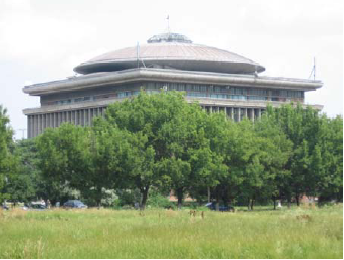22-23 november 2007
Bucharest, Romania.
CIEM
| 2007
3rd International
Conference on Energy and Environment
The International Conference on ENERGY and ENVIRONMENT (CIEM)
The International Conference on ENERGY and ENVIRONMENT (CIEM),
is
held every two year in Romania. The conference is organised by the
Power Engineering Faculty of the University POLITEHNICA of Bucharest.
CIEM2007 is the third event in the series of International Conference
on ENERGY and ENVIRONMENT. The aims of CIEM is to respond to challenges
in the rapidly developing fields of Power Engineering and Environmental
Engineering, and to inspire both research studies and practical
applications by promoting interaction among scientists from
universities, research institutions, and industry. Like the previous
events, CIEM2007 will provide an ideal venue for the development of new
partnerships.
We look forward to welcoming you to Bucharest.
ROMANIA
 ROMANIA was one of the least visited countries in Europe, till 15 years
ago. Closed for more than 40 years behind the "Iron Curtain" and almost
isolated from the rest of the world by a tough communist regime until
1989, Romania is a land of many genuine treasures that are waiting to
be discovered.
ROMANIA was one of the least visited countries in Europe, till 15 years
ago. Closed for more than 40 years behind the "Iron Curtain" and almost
isolated from the rest of the world by a tough communist regime until
1989, Romania is a land of many genuine treasures that are waiting to
be discovered.
Romania is one of the large countries of Europe (the size of the United
Kingdom or roughly half of France), with a population of approx. 22
million inhabitants. Along with the Romanians, Hungarians, Germans,
Serbs, Turks and other minorities also live in the country. Most of
them are of Greek-Orthodox religion, but there are also many Catholics,
Protestants, Evangelical, Muslims and others (more).
BUCHAREST
Modern European metropolis, mentioned for the first time at the end of the XIVth century, Bucharest is being the capital city of Romania since 1862. Also, Bucharest is the political, administrative, economical, social, cultural and academic centre of the country. Placed in the Romanian Plain, between the Danube and the Carpathians Mountains, on the banks of the Dâmbovita and Colentina rivers, with more than two millions inhabitants, Bucharest is one of the major cities in the South-Eastern Europe. After a long period of relative isolation imposed by the communist regime, Bucharest has become today an important industrial and commercial centre, a dynamic and attractive city by it's numerous and valuable places of interest: more than 600 historical and architectural monuments, more than 50 museums and art galleries, 22 theatres and concert halls, libraries, pleasure gardens (Cismigiu being the oldest one). The tourist offer of Bucharest, made of a thesaurus that reflects its history, is representative.